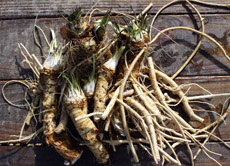TIP OF THE DAY: Horseradish Sauce

|
In the U.K., horseradish sauce has long been paired with roast beef. But its zinginess enhances other beef preparations from filet mignon to steak, brisket and corned beef; other meat dishes (pork, lamb, smoked chicken) including sandwiches; assertive seafood like mackerel, salmon and smoked fish; even veggies. To make horseradish sauce, you can use a base of sour cream or heavy cream, or substitute fat-free Greek yogurt. Made with fat-free yogurt, it’s a low-calorie sauce. You can add other flavor accents, from capers to herbs to Dijon mustard to lemon zest, all with negligible caloric impact. The sauce can be made in advance and stored in the fridge in an airtight container for up to 2 weeks. Ingredients 1. GRATE the horseradish root finely with a microplane into a small bowl. Mix it with a splash of white wine vinegar to prevent browning. 2. WHIP the cream until soft peaks form. Gently fold into the whipped cream with a pinch of salt and a few grinds of black pepper. Mix in the herb as desired. 3. PLACE in the fridge for 2-4 hours to allow the flavors to meld. Before serving, taste and adjust seasonings accordingly. Ingredients 1. GRATE the horseradish root finely with a microplane into a small bowl. Mix it with a splash of white wine vinegar to prevent browning. 2. PLACE all of the ingredients in a bowl and whisk together until smooth and creamy. 3. PLACE in the fridge for 2-4 hours to allow the flavors to meld. Before serving, taste and adjust seasonings accordingly. Believed to be native to southeastern Europe and western Asia, horseradish has been cultivated for some 3,000 years, prized for its culinary uses as well as for homeopathy. A pungent root, horseradish is a perennial plant in the Brassicaceae family* of cruciferous vegetables, known for their antioxidant, cancer-fighting properties. It is a root vegetable that is used as a spice. |
|
|
Like mustard, the raw plant is not pungent. The heat and aroma only appear when the appropriate part of the plant is crushed (mustard seeds), cut or grated (horseradish root), creating a chemical reaction. Once exposed to air or heat, the pungency begins to erode. Prepared horseradish is grated root that adds vinegar to preserve the pungency (and needs to be refrigerated). Why is it a “horse” radish? In German, the root is called meerrettich, sea radish, because it grows by the sea. It is believed that the English mispronounced the German word “meer” as “mare,” and began calling it mare radish, which evolved to horseradish. “Radish” comes from the Latin radix, meaning root. While horseradish and conventional radishes are both members of the Brassicacae family (“Brassica” in English), they are from different geniuses. The horseradish genus and species is Amoracia rustincana, and the radish is Raphanus sativus. During the Renaissance, horseradish consumption spread northward from Central Europe to England and Scandinavia. While it was used medicinally, it wasn’t until 1640 that the British began to eat horseradish, and then only by the rural people who grew it. But by the late 1600s, horseradish had become the standard English accompaniment for both beef and oysters. The English, in fact, grew the pungent root at inns and coach stations, to make cordials to revive exhausted travelers. Early settlers to the American Colonies brought horseradish to cultivate. It was common in the northeast by 1806. In the U.S., commercial cultivation began in the mid 1850s, when immigrants started horseradish farms in the Midwest. After World War II, horseradish was planted commercially in Northern California and other areas in the country. Today, approximately 6 million gallons of prepared horseradish are produced annually in the U.S., with a much smaller amount of fresh root sales. While the root gets all the press, horseradish leaves are also edible: raw or cooked, in pestos, salads, sautés and stir fries. They have a sharp, bitter, peppery taste similar to arugula and kale, their Brassica cousins. Horseradish.org, which supplied some of this information, has dozens of horseradish-related recipes from the expected (dips and sauces) to the intriguing (cream of horseradish soup with peas and bacon). Two of our favorite recipes are horseradish compound butter for steak, and horseradish mashed potatoes. *The Brassica family of cruciferous vegetables, called Brassicaceae in the Latin-based taxonomy system, includes bok choy, broccoli, Brussels sprouts, cauliflower, cabbage, horseradish/wasabi, kale, kohlrabi, mustard greens, radishes and turnips, among others.
|
||






